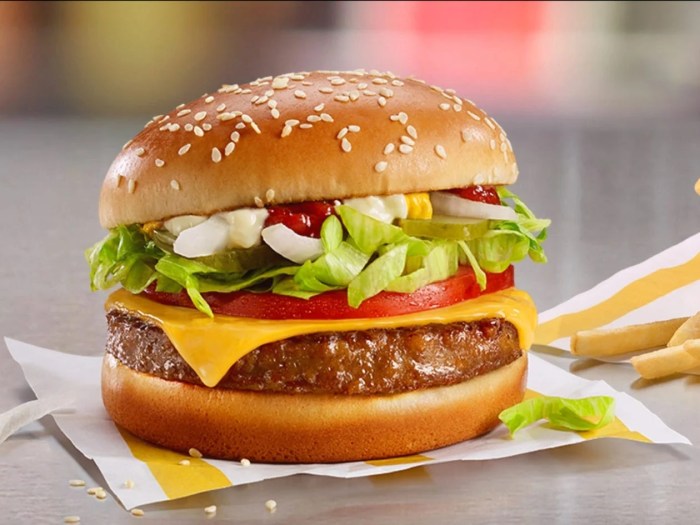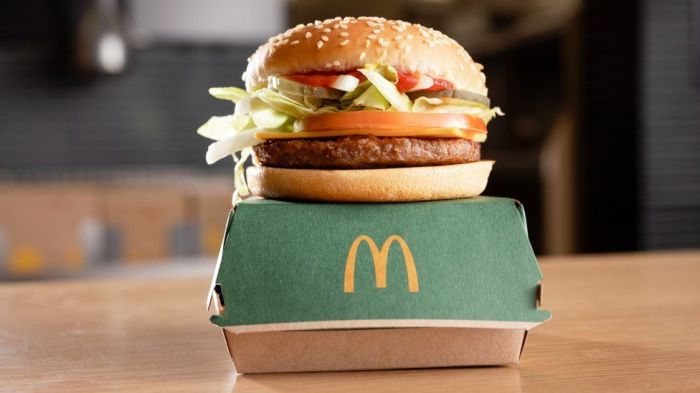
Why McDonalds McPlant Became a McFlop
Why mcdonalds mcplant became a mcflop – Why McDonald’s McPlant Became a McFlop is a story about ambition, innovation, and the fickle nature of consumer preferences. McDonald’s, the fast-food giant known for its iconic burgers, took a bold step into the plant-based market with the McPlant, a vegetarian burger designed to capture the growing demand for meatless options.
But despite a promising launch and initial hype, the McPlant ultimately failed to gain traction, leaving many wondering what went wrong.
The McPlant was launched with a marketing strategy that highlighted its sustainability and appeal to health-conscious consumers. McDonald’s partnered with Beyond Meat, a leading plant-based protein company, to create a patty that mimicked the taste and texture of beef. However, the McPlant faced a number of challenges, including its price point, its taste profile, and its lack of differentiation from other plant-based burgers already available in the market.
The McPlant’s Launch and Initial Reception
The McPlant, McDonald’s foray into the plant-based burger market, was launched with much fanfare in 2021. The company aimed to tap into the growing demand for meat-free options, hoping to attract a new customer base while appealing to existing ones.
Marketing Strategy
McDonald’s employed a multi-pronged marketing strategy for the McPlant. They partnered with Beyond Meat, a well-known plant-based meat producer, to create the patty. This collaboration aimed to leverage Beyond Meat’s existing brand recognition and consumer trust. McDonald’s also invested in extensive advertising campaigns, featuring the McPlant prominently in television commercials, social media posts, and in-store promotions.
The company emphasized the McPlant’s “real” burger taste, highlighting the fact that it was made with plant-based ingredients but still offered the familiar McDonald’s flavor profile.
Initial Consumer Reaction
The McPlant’s initial reception was a mixed bag. While some consumers were excited about the new offering, others expressed skepticism. Some praised the McPlant’s taste and texture, finding it to be a convincing alternative to traditional beef burgers.
However, others criticized the McPlant’s price point, which was higher than that of traditional burgers. Some consumers also noted that the McPlant’s availability was limited, only being offered at select locations. This limited availability made it difficult for many consumers to try the McPlant and contributed to the mixed initial reception.
The McPlant’s failure is a lesson in the challenges of appealing to both meat-lovers and plant-based eaters. It’s a tough balancing act, and sometimes, the best way to learn is by trying and failing. Meanwhile, the political landscape is also seeing a balancing act as former Transportation Secretary Elaine Chao met with the Jan 6 committee, as reported in this CNN article.
Perhaps, like the McPlant, this too will be a test of how to navigate a complex and polarized environment.
Comparison to Other Plant-Based Burger Launches
The McPlant’s initial reception was somewhat muted compared to other plant-based burger launches. For example, the Impossible Burger, another popular plant-based patty, experienced a surge in popularity upon its introduction. This success was attributed to its widespread availability, positive reviews from food critics, and strategic partnerships with major restaurant chains.
The McPlant, while attracting some attention, failed to achieve the same level of widespread adoption. This can be attributed to factors such as the limited availability, mixed consumer reviews, and the perception that the McPlant was simply a “me too” product in a crowded plant-based burger market.
McPlant’s Product Attributes and Challenges: Why Mcdonalds Mcplant Became A Mcflop

The McPlant, despite its initial hype, ultimately failed to achieve lasting success. While it was marketed as a plant-based alternative to McDonald’s iconic beef burgers, several factors contributed to its downfall. Analyzing the McPlant’s attributes and challenges reveals insights into its shortcomings and the broader landscape of plant-based alternatives in the fast-food industry.
McPlant’s Target Audience and Intended Appeal
McDonald’s positioned the McPlant as a plant-based option designed to attract both flexitarian and dedicated vegan/vegetarian consumers. The burger was intended to appeal to a wider audience by offering a familiar McDonald’s experience with a plant-based twist. Key features aimed at achieving this included:
- Familiar Flavor Profile:The McPlant was designed to resemble the taste and texture of a traditional beef burger, with familiar ingredients like pickles, onions, and ketchup. This familiarity was intended to attract meat-eaters who were curious about plant-based alternatives but hesitant to venture outside their comfort zone.
- Accessibility and Convenience:The McPlant was offered at participating McDonald’s locations, leveraging the brand’s established infrastructure and widespread accessibility. This convenience was a major selling point for consumers who were accustomed to the speed and ease of McDonald’s service.
- Marketing and Promotion:McDonald’s invested significant resources in marketing the McPlant, featuring it in commercials, social media campaigns, and in-store promotions. This broad marketing effort aimed to generate awareness and encourage trial among potential customers.
Challenges with McPlant’s Ingredients and Taste Profile
While the McPlant aimed for familiarity, it faced challenges in replicating the taste and texture of a traditional beef burger. This resulted in mixed reactions from consumers, with some finding the McPlant’s flavor profile underwhelming or lacking the satisfying “meatiness” they expected.
- Plant-Based Patty:The McPlant’s patty, made from a blend of pea protein, rice, and oats, struggled to deliver the same juicy and flavorful experience as a traditional beef patty. Some consumers found the patty to be dry or lacking in depth, while others criticized its texture, which was perceived as less satisfying than ground beef.
- Limited Ingredient Variety:The McPlant’s ingredient list was relatively simple, focusing on basic components like lettuce, tomato, and cheese. While this ensured familiarity, it also lacked the complexity and flavor layering found in many plant-based burgers from specialty restaurants and other fast-food chains.
This simplicity might have contributed to a perception of the McPlant as lacking in innovation or excitement.
McPlant’s Price Point Compared to Other Plant-Based Options
The McPlant’s pricing strategy also presented challenges. It was priced competitively with other McDonald’s menu items but was relatively expensive compared to other plant-based burgers available in the market.
- Competitive Pricing Within McDonald’s:The McPlant’s price point was designed to be comparable to other McDonald’s burgers, making it accessible to a wide range of consumers. However, this strategy might have limited its appeal to those seeking value for money, as many plant-based burgers from other chains were offered at lower prices.
- Higher Price Point Compared to Other Plant-Based Burgers:Despite its price competitiveness within McDonald’s, the McPlant was more expensive than many plant-based burgers offered by other fast-food chains and specialty restaurants. This price difference might have discouraged some consumers, particularly those who were price-sensitive or seeking more affordable plant-based options.
The McPlant’s failure might have been due to a lack of understanding of the target market. Perhaps, like the analysis in analysis chinas demographics spell decline not domination , McDonald’s underestimated the importance of appealing to a specific demographic.
Maybe, instead of focusing on the plant-based trend, they should have focused on what their customers truly wanted, even if it meant sticking with their tried-and-true meat-based menu.
Competition in the Plant-Based Burger Market

The McPlant’s failure to gain traction in the fast-food market can be partly attributed to the intense competition within the plant-based burger sector. While McDonald’s was a latecomer to the plant-based burger scene, it entered a market already dominated by established players like Beyond Meat and Impossible Foods.
Understanding the competitive landscape and the unique features of each competitor helps explain why the McPlant struggled to stand out.
Comparison with Beyond Meat and Impossible Foods
Beyond Meat and Impossible Foods have carved a significant niche in the plant-based meat market. Their products have gained popularity for their realistic meat-like flavor and texture, appealing to both flexitarians and committed vegetarians.
- Beyond Meat: Beyond Meat’s success can be attributed to its strong brand recognition and widespread availability in grocery stores and restaurants. The company has also actively collaborated with various fast-food chains, including Burger King, Dunkin’, and Subway, to offer their plant-based burgers.
- Impossible Foods: Impossible Foods has positioned itself as a leader in plant-based innovation, with its signature Impossible Burger replicating the taste and texture of beef remarkably well. The company’s focus on sustainability and its commitment to reducing meat consumption have resonated with environmentally conscious consumers.
McDonald’s McPlant was a valiant effort, but it ultimately fell flat. The burger just couldn’t compete with the familiar, meaty classics. It’s like how Paul Merson argues that Liverpool’s safer, more cautious style plays into Manchester United’s hands – sometimes, sticking to the tried and true is the way to go.
Perhaps McPlant simply wasn’t bold enough to break the mold and capture the hearts (and stomachs) of the masses.
- McPlant: In contrast to Beyond Meat and Impossible Foods, McDonald’s opted to develop its own plant-based patty, partnering with Beyond Meat for the initial launch. However, the McPlant’s flavor and texture were not as well-received by consumers as its competitors, lacking the “meatiness” that made other plant-based burgers appealing.
Competitive Landscape and Consumer Preferences
The plant-based burger market is highly competitive, with numerous players vying for consumer attention. Beyond Meat and Impossible Foods have captured a significant market share, but other brands, such as Morningstar Farms, Gardein, and Sweet Earth, are also gaining ground.
- Market Share: Beyond Meat and Impossible Foods hold the largest market share in the plant-based meat sector, with Beyond Meat accounting for approximately 30% of the market in 2022. However, the market is expected to grow significantly in the coming years, creating opportunities for new entrants and existing players to expand their reach.
- Consumer Preferences: Consumer preferences for plant-based burgers vary, with factors such as taste, texture, price, and sustainability influencing purchasing decisions. Some consumers prioritize the taste and texture of the patty, seeking a realistic meat-like experience. Others may prioritize affordability or the environmental impact of their food choices.
McDonald’s McPlant Strategy
McDonald’s McPlant strategy differed from its competitors’ approaches in several ways. Unlike Beyond Meat and Impossible Foods, which have actively partnered with various fast-food chains, McDonald’s initially opted to develop its own plant-based patty, partnering with Beyond Meat for the initial launch.
This decision may have contributed to the McPlant’s lack of brand recognition and limited appeal. Additionally, McDonald’s approach to marketing the McPlant focused on its “natural” ingredients and sustainability aspects, rather than emphasizing its meat-like qualities. This strategy may have failed to resonate with consumers who were seeking a plant-based alternative that tasted and felt like beef.
McPlant’s Sustainability and Environmental Impact
The McPlant was positioned as a more sustainable alternative to traditional beef burgers, but its actual environmental impact is a complex issue that requires a closer look. While the McPlant itself may have a smaller carbon footprint than a beef burger, its production and supply chain involve various factors that can influence its overall sustainability.
The McPlant’s Environmental Footprint
The environmental impact of a plant-based burger like the McPlant is determined by various factors, including the type of ingredients used, their sourcing, and the manufacturing process. The McPlant’s key ingredients, such as pea protein, soy protein, and vegetable oil, have a relatively lower carbon footprint than beef.
However, the overall impact of the McPlant is influenced by factors such as:
- Ingredient Sourcing:The origin and transportation of ingredients play a significant role in the McPlant’s environmental footprint. Sourcing ingredients locally and using sustainable farming practices can help reduce emissions associated with transportation and land use.
- Packaging:The packaging used for the McPlant, including the burger bun, patty wrapper, and other materials, also contributes to the overall environmental impact. Choosing sustainable packaging materials and minimizing packaging waste are important considerations.
- Manufacturing and Distribution:The energy consumption and emissions associated with manufacturing, processing, and transporting the McPlant to restaurants also contribute to its environmental footprint. Optimizing manufacturing processes and using efficient transportation methods can help reduce these impacts.
Comparison with Traditional Beef Burgers
Studies have shown that producing a pound of beef has a significantly higher environmental impact than producing a pound of plant-based protein. For instance, the production of beef is associated with deforestation, methane emissions from cattle, and high water usage.
In contrast, plant-based protein sources generally require less land, water, and energy, leading to a lower carbon footprint. However, it’s important to note that the specific environmental impact of the McPlant can vary depending on the factors mentioned earlier.
McDonald’s Sustainability Positioning
McDonald’s emphasized the McPlant’s sustainability aspect in its marketing campaign, highlighting the product’s plant-based nature and its potential to contribute to a more sustainable food system. The company also promoted its commitment to sourcing sustainable ingredients and reducing its environmental footprint.
While the McPlant’s sustainability claims are valid to a certain extent, it’s important to consider the overall environmental impact of its production and supply chain.
“We’re committed to sourcing sustainable ingredients and reducing our environmental impact. The McPlant is an important step in that journey.”
McDonald’s Spokesperson
McPlant’s Impact on McDonald’s Brand Image
The McPlant’s impact on McDonald’s brand image was a mixed bag. While it attracted new customers interested in plant-based options, it also faced challenges in appealing to the core McDonald’s customer base and maintaining consistency with the brand’s overall image.
McPlant’s Alignment with McDonald’s Brand Strategy
The McPlant’s launch aligned with McDonald’s evolving strategy to appeal to a wider customer base, particularly those seeking healthier and more sustainable options. This strategy was driven by several factors:* Growing demand for plant-based foods:The increasing popularity of plant-based diets and a rising awareness of environmental and health concerns related to meat consumption fueled the demand for plant-based options.
Competitive pressure
Other fast-food chains, like Burger King and Subway, had already introduced plant-based burgers, creating a competitive landscape where McDonald’s needed to offer similar options.
Sustainability efforts
McDonald’s was making efforts to improve its sustainability image and reduce its environmental impact. The McPlant was positioned as a way to contribute to these efforts by offering a plant-based alternative.
McPlant’s Reception and Public Perception
The McPlant’s reception was mixed. While it generated positive buzz and attracted some new customers, it also faced criticism for its taste and consistency, leading to concerns about its long-term success.* Positive reception:The McPlant was initially met with enthusiasm from some customers who were excited about a plant-based option from McDonald’s.
This was reflected in positive media coverage and social media discussions.
Negative reception
However, the McPlant also received criticism from some customers who found it lacking in flavor and texture compared to the traditional beef burger. This criticism, coupled with inconsistent quality and availability, led to concerns about the McPlant’s appeal to the core McDonald’s customer base.
McPlant’s Impact on McDonald’s Brand Image
The McPlant’s reception had a mixed impact on McDonald’s brand image. While it demonstrated McDonald’s willingness to adapt to changing consumer preferences and embrace sustainability, the product’s shortcomings also raised concerns about its ability to deliver on its promises.* Positive impact:The McPlant’s launch signaled McDonald’s commitment to innovation and its willingness to cater to a wider range of customer preferences.
This helped to improve the brand’s image among environmentally conscious consumers and those seeking plant-based options.
Negative impact
The McPlant’s inconsistent quality and negative reviews raised questions about McDonald’s ability to deliver a consistently high-quality product. This could have potentially undermined the brand’s reputation for delivering a reliable and satisfying fast-food experience.
McPlant’s Long-Term Viability and Future Prospects

The McPlant’s short-lived presence on the fast-food scene raises questions about its long-term viability and the future of plant-based meat options within the industry. While initial excitement was high, the McPlant faced challenges that contributed to its decline in popularity.
However, its journey also offers valuable insights into the evolving landscape of plant-based food and the strategies that may be needed for future success.
Factors Contributing to the McPlant’s Decline
The McPlant’s decline in popularity can be attributed to a combination of factors. These factors encompass both internal challenges faced by McDonald’s and external market forces that impacted consumer demand.
- Limited Appeal:The McPlant, while a commendable effort, may not have resonated with a wide enough consumer base. Some critics argued that its flavor profile lacked the distinct characteristics of a traditional beef burger, which could have limited its appeal to both meat-eaters and plant-based consumers.
- Limited Availability:The McPlant’s availability was initially restricted to select markets, which limited its exposure and reach. This limited rollout may have hindered its ability to gain traction and build momentum.
- Competition:The plant-based meat market is fiercely competitive, with established players like Beyond Meat and Impossible Foods offering a wide range of products. The McPlant faced stiff competition from these established brands, which may have contributed to its limited success.
- Consumer Perception:McDonald’s, known for its iconic beef burgers, may have faced a perception challenge in convincing consumers that the McPlant was a true alternative. Some consumers may have been hesitant to embrace a plant-based burger from a company synonymous with meat-centric offerings.
Potential for Reintroduction or Modification, Why mcdonalds mcplant became a mcflop
While the McPlant may have been discontinued, it doesn’t necessarily signal the end of McDonald’s plant-based ambitions. The company has a history of adapting to changing consumer preferences and could potentially reintroduce the McPlant with modifications to address the challenges it faced.
- Enhanced Flavor Profile:McDonald’s could refine the McPlant’s flavor profile to create a more appealing and distinctive taste, potentially drawing inspiration from successful plant-based burgers offered by competitors.
- Expanded Availability:A wider rollout across more markets could significantly increase the McPlant’s visibility and reach, allowing it to attract a broader consumer base.
- Marketing and Branding:A targeted marketing campaign emphasizing the McPlant’s sustainability and ethical aspects could help to build brand awareness and overcome any initial consumer skepticism.
Future of Plant-Based Meat Options in Fast Food
The plant-based meat market is expected to continue its rapid growth in the coming years. Fast-food chains are increasingly recognizing the demand for plant-based options and are actively incorporating them into their menus.
- Innovation and Variety:We can expect to see more innovative and diverse plant-based meat options, catering to a wider range of tastes and preferences. This could include new flavors, textures, and formats, such as plant-based chicken nuggets, sausage, and even plant-based bacon.
- Sustainability and Ethics:Plant-based meat alternatives are often promoted for their environmental and ethical benefits. As consumers become more conscious of these factors, we can expect to see fast-food chains emphasize the sustainability and ethical aspects of their plant-based offerings.
- Accessibility and Affordability:Fast-food chains play a crucial role in making plant-based options accessible and affordable to a wider audience. As competition intensifies, we can expect to see prices become more competitive, making plant-based options a viable alternative for budget-conscious consumers.






